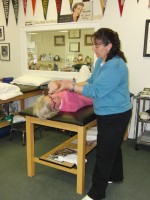Your P.T. Can be Your Best Friend
I know a thing or two about physical therapy, and about physical therapists, having had a serious sports injury or two. Torn ACL and ruptured Achilles tendon, among them. There have been times when my P.T. has been my best friend, because post-surgery due to lower leg injuries, it has been my P.T. who has re-taught me how to walk. Literally.
Having had more than my share of physical therapy, I also know a good P.T. when I meet one. And we have a great one, right here in Amagansett: Randi Cherill at Sports Therapy is the real deal. Smart, funny, compassionate, and the consummate professional. I met Randi after having my Achilles tendon repaired, and she got me up and running (well, maybe up and swinging…) in short order.
I reached out to Randi because I have had a number of students show up for a golf lesson, complaining of Frozen Shoulder. I’m not a doctor (nor is Randi) so it is not for me (or her) to diagnose my students, but I do need to learn how to manage people’s golf development when they have physical issues, particularly the stoic types who are willing to “swing through the pain,” which I am loathe to encourage as a general rule.
So… if you are suddenly unable to complete your golf swing due to restricted range of motion in your shoulder, it might be frozen shoulder. I leave it to Randi to provide some thoughts on the topic.
Ladies and Gentlemen: from Sports Therapy, Amagansett, NY
Randi Cherill, Physical Therapist on Frozen Shoulder
“What the heck is wrong with my shoulder? I can’t lift my arm to swing the club??
It is a beautiful, sunny day, 75 degrees, no humidity and no wind, not a cloud in the sky. The kids are at a friend’s house, cell phone is turned off, and there is a cooler filled with cold beer in the back of the cart… what could be more perfect?!!!
You approach the first tee, brimming with optimism. You bend down, tee up your ball, set your feet and assume the position for what will surely be the drive of the century. If only Golf Digest could see you now! Head down, eye on the ball…….nothing can rock you as you have entered “the zone”. You slowly rotate, loading Big Bertha with all the momentum she needs for this epic shot…….. when all of a sudden you feel a stabbing pain, and your swing thought changes to “Houston, we have a problem”.” Your left shoulder is not behaving and, in fact, – it hurts like hell! You now realize that the poor mobility in your arm and the nagging pain at night that you’ve ignored for weeks in the hope that it would just go away, isn’t going anywhere. It’s here to stay and it’s going to ruin your perfect day. You, my friend, may be suffering from “Frozen Shoulder.”
Simply explained, Frozen Shoulder is exactly what it sounds like – the tissues within the shoulder joint become tight and scarred, or frozen, and drastically limit the movement of your shoulder. How might this manifest itself?
With Frozen Shoulder you will be unable to:
- raise your arm out in front of you or overhead
- move your arm out to the side away from your body
- move your arm across your body
- rotate your arm away from your body
On the golf course, you might experience something like this. Let’s say you are a right handed golfer and it’s your left shoulder that’s ruining your day. As you try to initiate your back swing, your left arm will not move across your body, or the attempt to take the club away from the ball will cause significant pain. Your body’s natural reaction is to avoid that pain and therefore you compensate by adjusting mid-swing. This results in your entire body being off kilter and your epic tee shot remains a pipe dream!
The same thing occurs with your follow through. After you have hopefully made contact with the ball, and intend to continue through to a full finish, in theory your left arm wants to outwardly rotate as you strike a pose with your back arched and hands held high over your left shoulder. But…… your Frozen Shoulder has a very different game plan! Imagine what your follow through will look like if you are unable to raise your hands to head high and, probably more importantly, unable to release the clubhead because your shoulder won’t rotate?? NOT PRETTY!! I shudder to think of where your ball landed.
Vicious Cycle of Frozen Shoulder – why is this happening to me??
Don’t take it personally: Frozen Shoulder can affect anyone and can occur at any age. It can “come out of nowhere” and is often cannot be tied to any kind of traumatic event; nevertheless, something happens that triggers inflammation. Believe it or not, inflammation is your body’s natural defense system. Unfortunately, inflammation in the joint causes pain. The more pain that you feel, the less comfortable you are with moving your arm. The less you move your arm, the more scar tissue is allowed to form. The more scar tissue that forms, the more immobile your shoulder becomes. The more immobile your shoulder becomes, the greater the weakness in your surrounding musculature. Weakness in your shoulder musculature can lead to chronic compensation putting the rest of your body at risk for injury. Muscle spasms in your neck, upper back and chest muscles, as well as radiating pain down your entire arm are very probable complications from an untreated Frozen Shoulder. As far as being able to sleep through the night…..forget about it! 3am Info-mercials are going to become a constant companion!!
So, I can hear your next question already – what do I do about this??
The good news is that fixing a Frozen Shoulder is easier than perfecting your putting! The bad news is that it may take a while. “Playing through the pain” is a very bad idea. Pain is your body’s way of telling you that something is not right. Any pain or injury that you experience should ALWAYS be assessed by your medical doctor first. If your doctor has determined that you are indeed suffering from a Frozen Shoulder, you may be prescribed an anti-inflammatory treatment and/or a course of physical therapy. Follow the course!! Early treatment before the situation deteriorates further gives you the best chance of making a quick recovery. A home exercise program focusing on regaining range of motion and correct strengthening techniques is essential. Your physical therapist will teach you the safest and most efficient way to restore mobility and strength so you can get back on the links.
Remember, even professional golfers have a team of doctors and physical therapists. Use them!!!!! The rest of us are anxiously awaiting that epic shot!”
Randi Cherill will be featured as a guest blogger on LeslieAndrewsGolf.com throughout the summer. Check back from time to time to get Randi’s thoughts on Fitness and Golf.





 LinkedIn
LinkedIn
 Facebook
Facebook